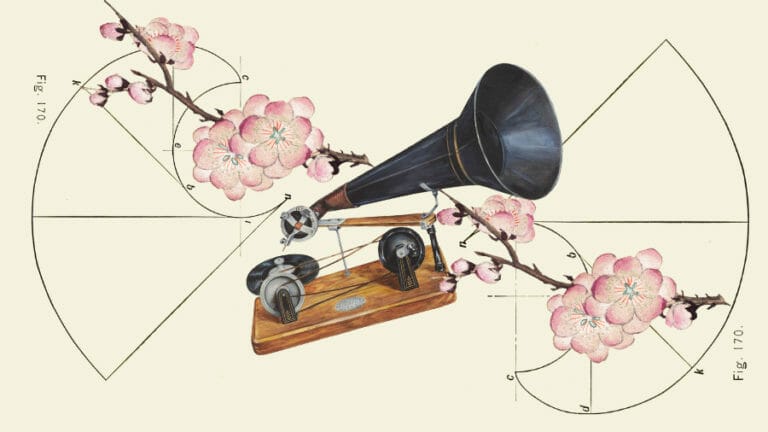When we think of music, we often relate it to a combination of instruments and vocals, coming together to create either harmonies or dissonance. Depending on the genre, music can also invoke different emotions within us—certain songs may make us feel happy or excited, while others can make us feel sad. Our understanding of music does not often extend beyond these boundaries, which is what Hazrat Inayat Khan’s The Mysticism of Sound and Music challenges. What if our spirituality itself can be likened to that of harmony and symphony?
Khan has a fresh take on this connection between music and our spiritual selves. Whatever we deem to bring us happiness, comfort, or profit are all compared to harmony, and, similarly, any negative feelings or things that bring on negative feelings are dissonance. “To attain spirituality is to realize that the whole universe is one symphony in which every individual is one note.”1 How can we better develop ourselves to be more in tune with the universe, our surroundings, and the very origin of sound that created it all?

In “The Silent Life” chapter of The Mysticism of Sound and Music, Khan focuses on a very important part of the whole that is music: vibrations. We know that any form of sound is created through vibrations, and Khan likens this to the creation of the earth and life itself.2
Essentially, earth came into existence when a single vibration sounded from the heavens—creating exponential vibrations in its wake. Silence no longer ruled because each new motion created unique variations of itself. We can view these variations as different planes of reality—and that is how our earth came to be. All forms of life, from plants to humans, are the result of continuous changes in vibrations in terms of sound, length, effect, and color.3 Mankind isn’t just made up of vibrations, however—as mentioned earlier, our planes of existence were created by these very vibrations, which means we are surrounded by them, too. All situations and conditions of life we find ourselves in, whether it be successes or failures, happiness or sadness, are driven by a combination of different vibrations. In a similar manner, all sensations are a product of varying activities of vibrations.
“Different parts of our being interpret different types of vibrations—some are perceived by our soul, which are classified as feelings.”—Hazrat Inayat Khan, The Mysticism of Sound and Music
We now know that there are endless types of these vibrations. However, Khan describes that there are two umbrella terms that these variations fall under: fine and gross. Different parts of our being interpret different types of vibrations—some are perceived by our soul, which are classified as feelings.4 Vibrations processed through our mind are our thoughts. What we see with our own eyes are the culmination of ethereal vibrations that have manifested themselves into a physical state, and make up the elements of fire, earth, air, and water. Amongst all of these, the finest vibrations are indeed what fabricate our own souls, giving us a conscience.
The active part of our consciousness is what is able to recognize and perceive sound, allowing us to witness our own voices. We, amongst all things, are derived from sound. If you were to strike nearly any object, it will respond with sound, declaring its inherent state of being. Color and sound alike work alongside the law of harmony to leave their effects on the soul; “to a fine soul color appears, and to a still finer soul sound.”5 All elements have tones, which are either warm or cold, and can have adverse effects on our mind and body—whether negative or positive.

From silence stems vibration, returning to silence.
The “Vibrations” chapter of The Mysticism of Sound and Music continues to delve into the concept of vibrations, and all life being birthed from silence. Khan declares that, in the silent life, there is only peace—no presence of joy. This is because the original state of our souls is just that: peace. Joy, which is in the nature of our souls, actually works against peace. Contrary to what many might think, all tragedy is caused by this disruption in peace. Peace provided our souls with innocence, since they had little to no experience of the world. Once our souls have gotten their fill of satisfaction from the exterior plane, it longs to return to the tranquil state of being it was always meant to be in.6
As mentioned in the previous chapter, there are two main types of vibrations: fine and gross. Khan elaborates on this idea in “Vibrations,” stating that the essential part of every being, or our spirit, is made up of fine vibrations, while gross vibrations make up what we know as matter. The latter is more subject to what Khan refers to as “change and destruction,” while the former isn’t nearly so. Essentially, anything that exists on the physical plane of existence is deemed as “living,” meaning that it is subject to decay, death, and destruction due to its composition of gross vibrations.7 With enough activity, they can form life—and mold together even further to create a living entity. The human body is made up of countless other tiny forms of life, from the follicles of our hair to the cells that run through our veins and compose our skin. Knowing this, we can come to an understanding that the level of activity within a vibration determines which plane it will be a part of.
Meanwhile, our spirits, which are composed of only the finest vibrations, exist on a different plane altogether, rendering them less susceptible to the concept of decay and destruction. The vibrations uttered by our souls, though amongst the finest of them all, are also the strongest, and can reach lengths unparalleled to any others. Khan likens these vibrations to that of an electric current that connects all souls.8 Though it may not be visible to the naked eye, all things are tied to one another through these vibrations. There is a reason yawns are contagious. There is a reason why someone’s smile is infectious, why one’s laughter can trigger an entire room to follow suit. Sympathy is a chord through which vibrations travel, tying man to his surroundings and allowing him to be in tune with nature, granting the ability of insight into future conditions.9 Sometimes, our bones swell and ache to signal incoming weather, but our ability to perceive future events usually ends there. On the contrary, insects will hide at the oncoming of a storm. Cats will hide away when they feel death looming over. Just like animals, plants will do the same; flowers will wilt during times of trial and tribulation, but flourish in times of happiness and prosperity. These events are not just coincidence—the reason man does not have access like the rest of life does to these seer-like abilities is due to the overshadowing nature of his ego, which disrupts vibrations.10

Thoughts, feelings, words and their undeniable force
The intensity of vibrations is what also determines our emotions. These active vibrations form what Khan describes as clouds, allowing us to feel and perceive our emotions. These clouds, however, if too active, can live up to their name, blocking our soul from a clear path to spirituality and weakening our mind and body. There must be a stable balance in the strength of these emotions and thought-vibrations in order to maintain a clear path for our soul. For example, if you were to rush through a recipe for baking a cake, subsequently turning the heat too high in order to get a faster result, you would end up burning the cake. This same line of reasoning can be applied to thought-vibrations—patience is required to maintain stability of both thoughts and emotions.11 Khan states that we can regulate this connection between thought and feeling as we would with how we speak, and what we say. If we were to speak in front of an audience, to persuade and convince them of something, we would do so with a gentle, sweet voice—not one of fierceness and anger. Adding the energy of spoken word to our thought-vibrations, additionally, can have a noticeable impact on their strength. These three forces are undoubtedly powerful, whether they are isolated or used in tandem. If someone speaks, feels, or thinks poorly of someone else, those vibrations can oftentimes be felt by the receiver, no matter the distance. The same goes for feelings of fondness, intimacy, and love; we can conceal these thoughts, feelings, and words, but the sheer power of vibrations prevents them from ever being completely hidden.12
Though we perceive all different planes of existence to be completely separate from each other, it is actually true for the opposite. As mentioned previously, our souls are in a constant state of trying to return to peace. This means that any disturbance to this path affects every part of existence as a whole. Be it words, feelings, or thoughts; if it obstructs the goal, it is considered sinful and evil. On the flip side, good deeds are considered a means of clearing the path to peace, and comforts the system as a whole. Khan reasons that this is where good and bad “karma” come into play—sins are punished, and good deeds are rewarded by the higher powers.
In the final chapter of the excerpt, called “Mind and Heart,” Khan describes what exactly constitutes our heart. In essence, it is made up of five principal factors: thought, memory, will, reason, and ego. The latter is considered a completely separate part compared to the former four, which are considered to be “faculties” while ego stands as “reality.”13 Khan compares this to our thumb and our hand: the thumb is not considered a finger because it determines the strength of our hand as a whole—as does ego with the heart.

Alongside this, the heart is dubbed as a lantern, with our spirit being the light inside of it. Khan uses this analogy in order for us to see both our heart and spirit as two parts that constitute a whole, and that they would not exist properly as they should without each other. We also tend to think of the heart as a physical part of our body—a part that is located in our chest. Though it may be technically true on a physical level, Khan engages the idea of viewing our heart in the same plane that our spirit exists on, rather than being a mere body part.
Tuning into the subtle frequencies of the heart
We may view the heart as a physical body part due to the fact that we are able to feel emotions in our chest. These feelings are, but are not limited to, mirth, grief, anger, passion, sympathy, attachment, fear, bewilderment, and indifference. These nine are the most distinct that we experience throughout our lives. And just like there are nine distinguishable emotions, there are also six diseases of the heart that Khan names: passion, anger, infatuation, conceit, jealousy, and covetousness. In essence, the heart is the window to our personality.14 All things that we know of ourselves and believe about ourselves are contained within our heart. To fully understand the enigma of the heart is to speak the language of the universe.
How does the mind tie in with the heart, though? The answer lies in the three methods of perception, two of which are indeed the mind and the heart. Our thoughts manifest in our mind, where they are then sent to the heart, where we are able to feel and process these thoughts. This is not done on the surface of the heart, but the depths of it. The deeper someone is able to dive into their heart to dissect these thoughts into feelings, the more “sensitive” this person becomes, and the better he is able to perceive his surroundings and vibrations compared to someone who is only able to perceive thoughts and feelings on the surface of the heart.

The third method of perception is not so simple—it is more of a spiritual language, and takes place in the deepest crevices of the heart, where our spirit resides. It occurs in the light of the lantern, and we all know it by a very familiar name, intuition. Our intuition is the strongest of all forces, taking precedence over both the heart and the body.15
It is through mastering these three methods of perception that one is able to be in tune at the highest level with nature and their surroundings, with vibrations that we are not only made of, but surrounded by. Developing these three tools will allow one to find their note in the symphony of the universe, unlocking the mystery of sound and music.
Endnotes:
1 Khan, Inayat. The Mysticism of Sound and Music: The Sufi Teaching of Hazrat Inayat Khan. Shambhala, 1996, pp. 110. 2 Ibid., 121. 3 Ibid., 120 4 Ibid., 120. 5 Ibid., 121. 6 Ibid., 121. 7 Ibid., 124. 8 Ibid., 125. 9 Ibid., 126. 10 Ibid., 126. 11 Ibid., 128. 12 Ibid., 128. 13 Ibid., 233. 14 Ibid., 234. 15 Ibid., 235.
